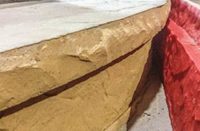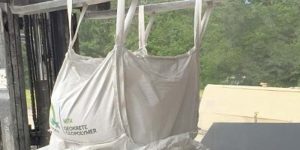 Cutting lines, grooves and control joints with diamond blades is nothing new for concrete contractors, but enterprising craftsmen have been putting their creativity to the test by using the blades to produce decorative borders, graphic designs or V-shaped grooves that look like they were hand-tooled.
Cutting lines, grooves and control joints with diamond blades is nothing new for concrete contractors, but enterprising craftsmen have been putting their creativity to the test by using the blades to produce decorative borders, graphic designs or V-shaped grooves that look like they were hand-tooled.
Tom Ralston, a third-generation concrete contractor from Santa Cruz, Calif., most often makes decorative saw cuts on interior floors in grid patterns (two-by-two-foot squares or three-by-three-foot diagonals) but says diamond blades can be used to cut any variety of designs.
“You can slice and dice a floor up like a boarding house pie,” he says. Diamond blades can be used to cut both green and cured concrete, using a variety of right-angle grinders, hand-held circular saws, Dremel tools or walk-behind saws. A variety of blades are available in the market, each serving its own purpose.
Ralston uses Norton/Clipper Corp.’s Slab Crab, a new saw with wide rubber wheels that allows him to cut perfectly straight lines; a Soff-Cut saw for structural cuts in green concrete; a four-inch grinder to make circular patterns; and a Dremel tool.
He likes to get out on the slab days after it’s poured, lay out the design on his hands and knees, snap the lines using orange chalk — which doesn’t stain the concrete — and make his cuts, often by hand. The saw cuts can act as small dams, making it easy to use different acid stains in the design without the colors bleeding into one another. For example, he created a unique design on a residential entryway using Italian marble in one section, black acid stain in another, antique amber with bits of real copper in another, and deep score joints filled with copper epoxy.
Blade basics
A diamond blade is a circular steel disc with a diamond rim, which can be segmented, continuous or serrated. The rims are made up of a mixture of diamonds and metal powders that hold the diamonds in place.
As the blade hits the concrete, this bond wears away, exposing the diamond crystals that grind the material into a fine powder, says Thom Fisher, advertising and trade show manager for Diamond Products, Elyria, Ohio.
One general rule of thumb is to use a soft bond to cut cured concrete and a hard bond to cut green concrete. A soft bond will expose the diamonds quickly to cut harder materials, while the harder bond will wear away more slowly to cut softer materials. Fisher’s company provides contractors with a map that shows how aggregate differs in hardness in various areas of the country — an important consideration in choosing a blade. And if a contractor has trouble with a blade, Diamond Products can provide a custom bond within 48 hours.
Making sure the blade matches the saw is another consideration. “The quality of the blade needs to match up with the horsepower of the saw,” he says. “If you’re using a small saw for a small job, you don’t need a top-quality blade that’s loaded with diamonds and costs a fortune.”
However, Fisher says contractors will regret choosing blades merely on price, because the industry is loade d with cheap imports — at the World of Concrete show last year, he says, 60 of 65 diamond blade companies were from overseas. “The old axiom, ‘You get what you pay for,’ really applies here,” he says.
Ted Skaff, market specialist for Pearl Abrasive of Commerce, Calif., says distributors should ask contractors two main questions: “What saw are you using, and what exactly are you cutting?” He’s found that more contractors are scoring lines, swirls, circles or other decorative elements in green concrete.
General purpose blades are usually used on cured concrete because using them on green concrete can cause excessive blade wear and undercutting, but Skaff says contractors are having good luck using a general purpose, narrow-slot turbo rim blade to cut green concrete because decorative concrete lines are shallow — typically only one-sixteenth to one eighth-inch deep. “You can have your cake and eat it too,” he says. “Not everyone knows that.”
 Even though a segmented blade will cut faster, decorative concrete contractors are looking for a smooth, crisp edge. “A segmented blade tends to chop, as opposed to cutting or grinding. They leave a rougher edge,” Skaff says. “That’s why we recommend turbo blades, and to break that down even further, a narrow-slot turbo blade is cleaner still. The closer the slots are together the cleaner the cut is going to be.”
Even though a segmented blade will cut faster, decorative concrete contractors are looking for a smooth, crisp edge. “A segmented blade tends to chop, as opposed to cutting or grinding. They leave a rougher edge,” Skaff says. “That’s why we recommend turbo blades, and to break that down even further, a narrow-slot turbo blade is cleaner still. The closer the slots are together the cleaner the cut is going to be.”
Soff-Cut International Inc., the industry leader in manufacturing green concrete saws, is offering blades that “chase” existing cuts, carve V-shaped grooves or create rounded edges that produce a hand-tooled effect, says Soff-Cutt’s Brenda Nabarette.
Soff-Cut offers an “ultra early entry” dry-cutting system that controls random cracks because control joints can be cut within an hour or two after the finishing process. This relieves internal stresses in the concrete before it dries out and cracks on its own. The profile blades are used after the initial cut to create a decorative look, saving contractors time and money over doing it by hand, Nabarette says.
Rudy Tena, owner of Tennaco Concrete in Eugene, Ore., specializes in large slabs and swears by Soff-Cut as a magic bullet against cracking. “The surface tension isn’t there yet because there’s still enough water inside the slab, as opposed to if you wait until the next day and try to wet cut it with a water saw, most of your surface tension has cracked.” He’s cut a floor in a 20,000-square-foot building without a crack. A common problem with green cutting is spalling, but Soff-Cut’s skidplate prevents that. Tena advises contractors new to green cutting to be careful when making cross cuts. When you’re making a T in the slab, those little corners can break off easily, so make sure to use plastic joint protectors and slow the saw down one or two speeds, he says.
Other early-entry saws include N-E-D Corp.’s Robo-Kut saw, with an adjustable speed blade that reacts to the load on the motor. Torque control keeps a constant load on the blade, even while running through a hard spot.
Besides the walk-behind saws, contractors are using hand-held Skil Saws, grinders or Dremel tools with diamond bits for fine control. Star Diamond Tools offers a convex blade used with an angle grinder that can cut circles. Their diamond engraving pins can create scored lines and reach tight corners.
Ralston, who often cuts with a hand-held saw, advises contractors to use a guide if they’re not sure they can cut a straight line. He also suggests that contractors use an eighth-inch round diamond bit on a Dremel tool to get close to a wall without damaging it. And of course, always use a sharp blade.
“Figure extra blades into your bid so you can always have an easy, fast and straight cut,” he said. “If you allow your blade to get dull, it can wobble on you and you’ll get a real crooked line.”
Dealing with dust
Dust collection products were once considered luxury items, but are increasingly being mandated by the EPA, OSHA and unions to protect workers from the health hazards of breathing fine silica dust into their lungs.
John Buser, owner of San Diego-based Shave Away, Europe, says the primary reason to use dust control products is to protect workers’ health. But there are other reasons: Dust can also shorten the life of power tools, prevent contractors from seeing what they’re doing, and make a mess that property owners and sub-contractors hate. “I can tell you that every day a high percentage of our orders are expedited because our customers have been run off the job, or OSHA or EPA has come down and says you have to control the dust.”
Shave Away’s Dust Muzzle, which retrofits more than 1,200 grinders and sanders, can remove up to 99 percent of pollutants at the point of origin when connected to a high-quality industrial vacuum. The Dust Muzzle — transparent, lightweight and flexible — is typically used for flat grinding or crack chasing, Buser says, and the Saw Muzzle, used with hand-held circular saws, is often used to control dust when contractors are scoring lines in decorative concrete work. The company also offers a Saw Muzzle for gas-powered saws.
A learning process
Creative contractors like Ralston find that they can always learn something new by experimenting, even if the results aren’t what they expected. What was merely a fix for a mistake on one job can be an effective technique to use on the next project.
“If necessity is the mother of invention, then desperation is the father,” he says.
Ralston has a passion for his work and is always looking to imp rove his craft. “‘Forge forward, don’t look back and keep you thoughts fertile,’ that’s our saying here.”
The right blade, and the right craftsman behind it, can certainly create some stunning decorative effects. As contractors gain experience in using the tools and methods that will achieve the look they want, diamond blades will no doubt become even more common on decorative concrete job sites.

















